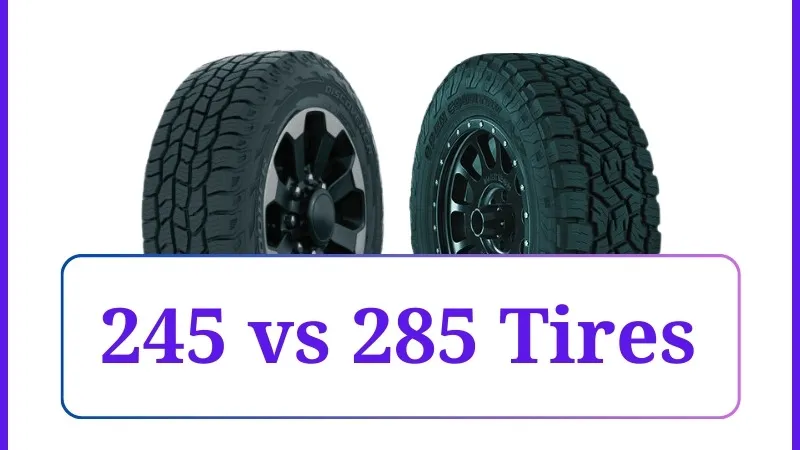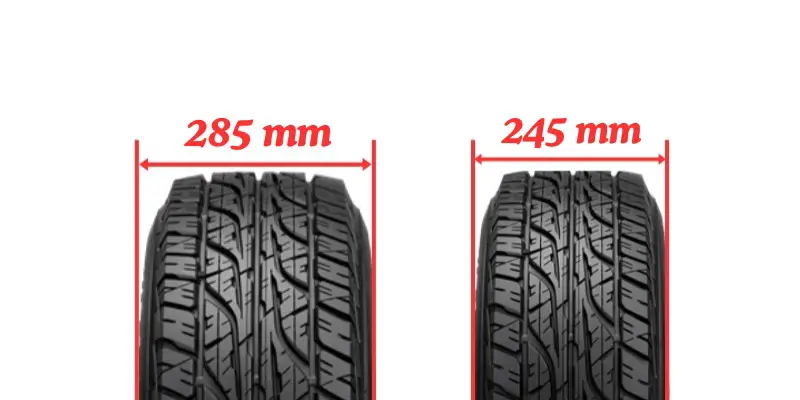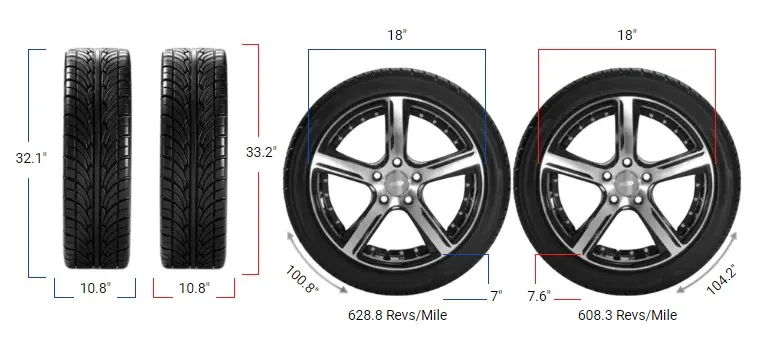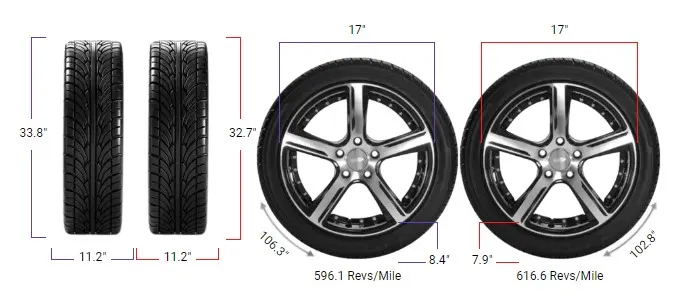245 vs 285 Tires

The numbers 245 and 285 refer to the tire’s width in millimeters. The 285 tires is about 40 mm wider than the 248 tires.
A 245 tire is 245 millimeters wide, while a 285 tire spans 285 millimeters. This difference of 40 millimeters may seem minor, but it can significantly affect various aspects of your driving experience.
The Fitment Factor
Upgrading or swapping tires isn’t just about choosing a size; it’s also about ensuring they fit your vehicle’s rims properly. Each tire width has an ideal rim width range to maintain optimal performance and safety.
- 245 Tires: Best suited for rims that are 7.5, 8.0, 8.5, or 9.0 inches wide.
- 285 Tires: Compatible with rims measuring 9.5, 10.0, 10.5, or 11.0 inches in width.
Unfortunately, in the case of 245 and 285 tires, there’s no overlap between their recommended rim widths. This means that directly swapping between these two sizes isn’t advisable.

Performance & Handling
- 245 Tires: Generally offer a balance between grip and fuel efficiency. They provide adequate road contact for most driving conditions, making them suitable for daily commuting and light performance use.
- 285 Tires: With a wider footprint, these tires enhance traction, especially in high-performance scenarios. They’re favored in sports cars and trucks that require superior grip and stability during aggressive driving or off-road conditions.
Fuel Efficiency
Wider tires like the 285s increase rolling resistance, which can lead to reduced fuel economy. If efficiency is a priority, the narrower 245 tires might be the better choice, offering less drag and better mileage over time.
Comfort & Noise
Narrower tires typically produce less road noise and offer a smoother ride due to their ability to absorb bumps more effectively. The 245 tires might provide a quieter and more comfortable driving experience compared to the broader 285s.
Why Overlap Matters
Mounting a tire on a rim that’s too narrow or too wide can lead to:
- Poor Handling: The tire may not seat properly, affecting steering response and stability.
- Increased Wear: Uneven contact with the road can cause premature tire wear.
- Safety Risks: There’s a higher chance of tire failure, which can lead to accidents.

Benefits of 285 Tires:
- Enhanced Traction and Stability: The wider contact area offers superior grip, especially during high-speed driving and off-road conditions.
- Aggressive Aesthetics: 285 tires give vehicles a more rugged and aggressive appearance, which can be appealing for those seeking a sportier look.
- Improved Off-Road Capability: The larger footprint provides better flotation on loose surfaces, making 285 tires ideal for off-road driving.
Drawbacks of 285 Tires:
- Lower Fuel Efficiency: The increased rolling resistance of 285 tires can lead to reduced fuel efficiency, particularly during city driving.
- Increased Road Noise: The wider profile may contribute to more road noise, which can be noticeable at higher speeds.
Benefits of 245 Tires:
- Better Fuel Economy: The narrower width reduces rolling resistance, resulting in better fuel efficiency, making 245 tires ideal for long commutes.
- Easier Maneuverability: The lighter steering effort makes 245 tires easier to handle, particularly in urban environments.
- Quieter Ride: The reduced contact patch helps minimize road noise, contributing to a more comfortable and quieter driving experience.
Drawbacks of 245 Tires:
- Limited Traction: Compared to 285 tires, 245 tires have a smaller contact patch, which can reduce traction, especially in wet or off-road conditions.
- Less Aggressive Appearance: 245 tires may not provide the same visual appeal as the wider 285 tires, which can be important for those seeking a more rugged look.

Making the Right Choice
Before deciding between 245 and 285 tires, consider the following:
- Vehicle Specifications: Always refer to your vehicle’s manufacturer recommendations. They provide guidance on suitable tire sizes and rim widths.
- Driving Needs: Assess whether you prioritize performance, fuel efficiency, or comfort.
- Professional Advice: Consult with a tire specialist or mechanic who can offer personalized recommendations based on your vehicle and driving habits.
Difference Between 245 and 285 Tires
The main difference between 245 and 285 tires is their width. 285 tires are 40mm wider than 245 tires, which impacts handling, stability, and overall vehicle performance.
Can I Use 245 Tires Instead of 285?
No, you cannot use 245 tires instead of 285 tires because their ideal rim width ranges do not overlap. This lack of overlap means the fitment would be unsafe, affecting performance, handling, and safety.
Make sure the aspect ratio and rim diameter match, or that the overall diameter difference is within 3% to maintain safety and accuracy.

Can I Use 285 Tires Instead of 245?
No, you cannot use 285 tires instead of 245 tires because their ideal rim width ranges do not overlap, making them incompatible. Using wider tires on narrower rims could compromise safety and negatively affect handling.
Ensure the aspect ratio and rim diameter are the same, or that the overall diameter difference is within 3% to maintain safety and performance.
Can You Put 245 Tires on 285 Rims?
No, you cannot put 245 tires on rims designed for 285 tires. The ideal rim width ranges for these tires do not overlap, leading to improper fitment, which may result in safety and performance issues.
Can You Put 285 Tires on 245 Rims?
No, it is not possible to put 285 tires on rims designed for 245 tires, as their ideal rim width ranges do not overlap. This would make the fitment unsafe and negatively impact vehicle handling and overall safety.
Conclusion
Choosing between 245 and 285 tires involves more than picking a width; it’s about understanding how that choice affects your vehicle’s performance and safety.
Given the lack of overlap in their ideal rim width ranges, swapping between these two sizes isn’t recommended. Always ensure compatibility to enjoy a safe and optimal driving experience.



